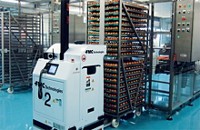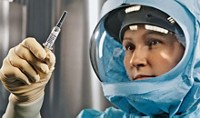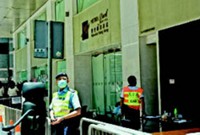Advertisement
Grab your lab coat. Let's get started
Welcome!
Welcome!
Create an account below to get 6 C&EN articles per month, receive newsletters and more - all free.
It seems this is your first time logging in online. Please enter the following information to continue.
As an ACS member you automatically get access to this site. All we need is few more details to create your reading experience.
Not you? Sign in with a different account.
Not you? Sign in with a different account.
ERROR 1
ERROR 1
ERROR 2
ERROR 2
ERROR 2
ERROR 2
ERROR 2
Password and Confirm password must match.
If you have an ACS member number, please enter it here so we can link this account to your membership. (optional)
ERROR 2
ACS values your privacy. By submitting your information, you are gaining access to C&EN and subscribing to our weekly newsletter. We use the information you provide to make your reading experience better, and we will never sell your data to third party members.
Pharmaceuticals
Vaccine Business Gets Second Look
After a fallow period, vaccines are gaining importance in the pharmaceutical pipeline
by Vivien Marx
October 3, 2005
| A version of this story appeared in
Volume 83, Issue 40
Despite the need for vaccines, particularly in the developing world, the vaccine market has traditionally been considered a lackluster corner of the pharmaceutical world. It is dull no longer.
This year alone, Novartis has bid for full control of vaccine maker Chiron, and GlaxoSmithKline (GSK) bought three vaccine-related operations: ID Biomedical for $1.4 billion, the vaccine adjuvant maker Corixa for $300 million, and a former Wyeth vaccine facility in Marietta, Pa. GSK says it plans to launch five vaccines over the next five years. Sanofi Pasteur, the vaccine business of Sanofi-Aventis, has landed several contracts with the Department of Health & Human Services (HHS), most recently a $100 million contract related to avian flu.
Vaccines had been "a bit of a backwater market," says Michael Leacock, pharmaceutical analyst with Nomura International's equity research team in London. There was even a flu vaccine glut in the late 1990s. Today, in contrast, pharmaceutical companies are expanding their manufacturing capabilities and vaccine supplies, and moving novel types of vaccines down their pipelines.
Last year's flu vaccine shortage, caused in part by manufacturing problems at Chiron in the U.K., highlighted the complexity of the vaccines and the tenuousness of their supply. As Wayne Pisano, senior vice president for commercial operations at Sanofi Pasteur, explains, emerging infectious diseases such as West Nile virus, severe acute respiratory syndrome (SARS), and avian flu have also raised the profile of vaccines.
Analysts also see a promising number of vaccines, even potential blockbuster products, coming down the pipeline. John Savopoulos, lead infectious diseases analyst at market research firm Datamonitor, says cervical cancer vaccines from Merck and GSK are both novel and "heavyweight" in terms of revenue potential.
Comparing vaccines to pharmaceuticals, Sanofi's Pisano makes the point that vaccines "are very capital intensive." His company just broke ground on a new influenza facility in Swiftwater, Pa., costing $150 million, excluding the cost of packaging and filling. Such investments are prohibitive for newcomers and even some old-timers.
The total global vaccine market is valued at about $9.3 billion, which, as Pisano says, is almost "a rounding error" in the overall pharmaceutical market. Yet profitability is as good as in conventional drugs, Leacock points out. One important hurdle is the complex manufacturing: The Food & Drug Administration won't approve a vaccine without inspection of the vaccine manufacturing facility. "So you need the facility; you need to build the plant or acquire it well ahead of time," he says.
Sanofi and GSK are virtually "neck and neck" in the vaccine market in terms of revenue. According to Pisano, both have about 24% market share, followed by Merck, Wyeth, Chiron, and others.
LIKE SANOFI, GSK has been seeking to build up vaccine manufacturing capacity, which explains its recent acquisitions. The company has more than 20 vaccines in clinical development, with five major vaccines slated to be introduced over the next five years. It also plans to increase its presence as a U.S. vaccine manufacturer.
Capacity is needed particularly for the influenza vaccine, where demand "remains well above capacity," according to Nomura's Leacock. Datamonitor's Savopoulos says that margins within the business are low relative to a high cost of goods associated with vaccine production. "Pricing thresholds are more favorable in the U.S. market than other regions," he says. That factor and some policy shifts due to last year's shortage are making the market more appealing to manufacturers.
The main flu vaccine market players, Leacock explains, are Sanofi with about 51% of the market, Chiron with about 25% when it operates at capacity, and GSK at 11%. Solvay and others make up the remaining 13%. Until last month, the U.S. market was left mainly to Sanofi and Chiron, but GSK has just been granted U.S. approval for its flu vaccine.
Chiron, whose contaminated flu inventory contributed to last year's U.S. flu vaccine shortage, had hoped to ramp up production for the 2005-06 vaccine season but has scaled back its estimate to around 22 million doses, Leacock says, a far cry from the firm's full capacity of an estimated 75 million doses a year. The flu vaccine market, he says, "remains even more short of vaccine" than it has been in the past, with total doses available for 2005-06 forecast to be fewer than 250 million.
Overall, manufacturers aim to double capacity over the next three years. "We see the market growing to a little over 550 millon doses by 2009," which is more than twice the estimated output for 2005-06, Leacock says. When the flu shortage occurred, GSK and Sanofi had already committed to more capital expenditure in flu vaccine manufacture.
The vaccine manufacturing process involves growing the desired virus in fertilized hen's eggs, with each egg delivering three doses of vaccine. Leacock uses the term "quaint" to describe part of the technology involved in this process. Savopoulos says problems experienced during the Chiron debacle "can happen at any time due to the long, unpredictable nature of the current flu vaccine generating process."
Because of the vagaries of flu vaccine production, vaccine makers are exploring cell culture production methods. Solvay, for example, is stepping up its flu vaccine manufacturing capacity, currently at about 20 million doses annually, and hopes to double output in 2006 by using cell culture methods. It might well be the first firm to launch a vaccine produced by cell culture in a plant that comes online next year.
Earlier this year, Sanofi Pasteur was awarded a $97 million, five-year contract from HHS to design a cell culture facility able to supply up to 300 million flu vaccine doses annually. This effort applies cell line technology by Crucell, a Dutch biotechnology company, with Lonza Biologics contributing to the scale-up engineering of the facility.
While GSK's current flu vaccine is produced in eggs, the company says it "expects the newly acquired Marietta site to play a significant role in the development of tissue-culture technology" for the next generation of flu vaccines.
While new technology is in the wings, vaccine makers are still counting their chickens. Sanofi's new facility in Pennsylvania will be egg-based. GSK is expanding its egg-based site in Germany, and one of its new acquisitions, ID Biomedical, is building a new egg-based plant in Canada. "It is our perspective that the egg-based technology will be with us for at least another 10 years," Pisano comments.
Pisano believes that cell culture would save two to six weeks in the time-sensitive flu vaccine production process. An extra six weeks could increase capacity by 20-25% as well as offer a more predictable manufacturing process, he says. Sanofi uses cell culture technology to produce its polio vaccine and is working on cell culture processes for influenza. "But the jury is still out on whether anybody is going to be successful in developing a cell culture vaccine and be able to scale it up," he says.
PART AND PARCEL of the flu vaccine market dynamic are governmental efforts, in the U.S. and elsewhere, to increase capacity and prepare for a possible flu pandemic. Authorities are concerned about the particularly pathogenic H5N1 strain of avian flu, which, according to the World Health Organization, could cause 1 million to 2.3 million hospitalizations and up to 650,000 deaths worldwide. Originally detected in birds, the virus has managed to jump the species barrier to other animals and humans.
Public-private collaborations are helping ramp up capacity for antiviral drugs such as Roche's Tamiflu and GSK's Relenza. As Leacock says, both firms stand to gain revenue in the short term, but he says they "face capacity constraints, long lead times, and uncertain efficacy." Sanofi, GSK, and Chiron, meanwhile, are all developing a vaccine against H5N1, and, in Leacock's estimation, Sanofi is "well ahead of the pack."
Sanofi has signed a string of agreements since 2004 with the U.S. government concerning H5N1, including a contract worth $41 million to establish a flock of egg-laying hens to ensure the ability to manufacture pandemic influenza vaccine.
But pandemics and shortages are not the only reason for bullishness about the vaccine market. Datamonitor's Savopoulos points to "high expectations" connected to the two new vaccines against human papilloma virus (HPV). GSK's Cervarix and Merck's Gardisil are slated to "add significant revenue to the overall market with $3 billion to $4 billion peak sales," he says. HPV infection, according to the American Cancer Society, is the most important risk factor for the development of cervical cancer.
Other movement in the vaccine market involves potential blockbusters as well as new market positioning. Chiron, which is now the target of a takeover by Novartis, has "aggressive vaccine plans," Savopoulos says. For example, Chiron is developing a meningitis C vaccine that is slated to compete with Sanofi's already-approved meningitis vaccine Menactra. He expects meningitis C to be a billion-dollar market.
Public-private efforts in vaccines are also geared to address needs in developing countries. Britain, France, Spain, Italy, and Sweden plan to raise $4 billion on the bond market to expand immunization programs in developing nations. This money will add to the funds available to the Global Alliance for Vaccines & Immunization, an alliance made up of governments, vaccine makers, research institutes, the World Bank, and nonprofit groups such as the Bill & Melinda Gates Foundation.
As Pisano explains, travel contributes to the market overlap between developed and underdeveloped countries. Vaccines are needed for diseases that are endemic in tropical areas. They are also the vaccines needed by travelers to those areas. "We are able to generate an adequate return in the developed world to cover the cost so we can produce vaccines for the developing world," he says.






Join the conversation
Contact the reporter
Submit a Letter to the Editor for publication
Engage with us on Twitter